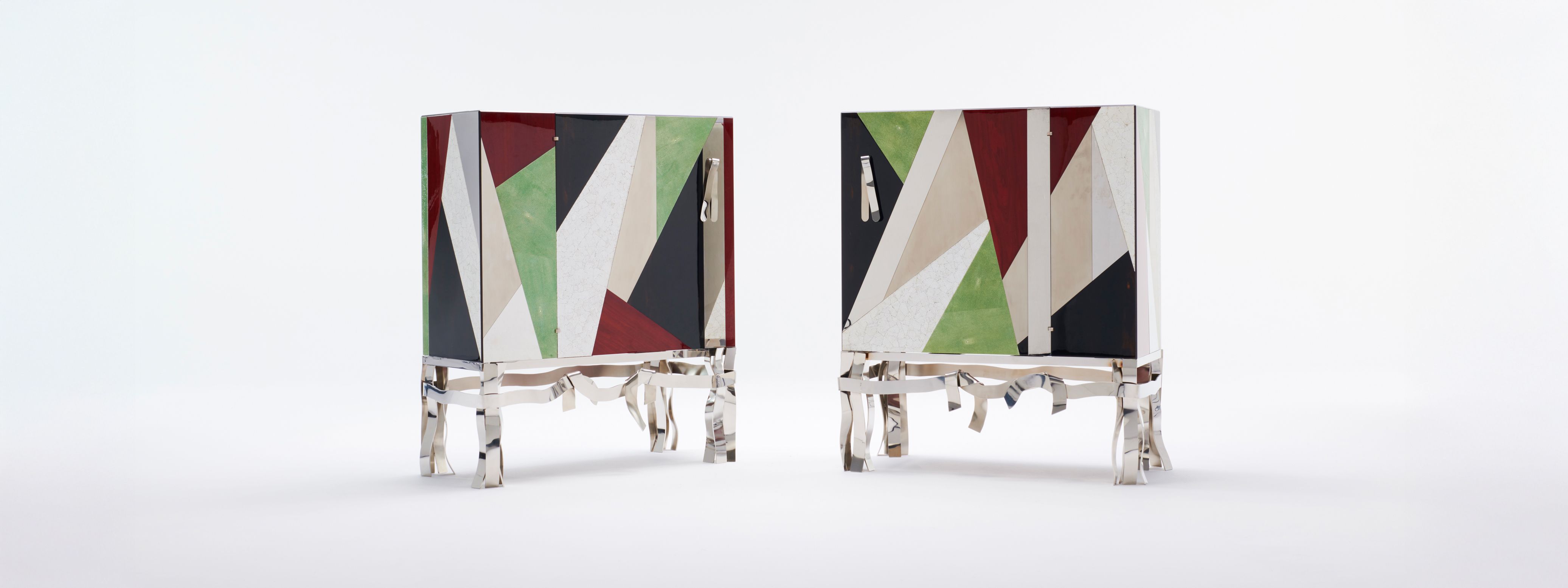
Maria Pergay
b. 1930 - d. 2023
Maria Pergay (b.1930 d.2023)
Copper is too fragile, aluminum too light, gold too symbolic, silver too weak, bronze is out of fashion and platinum is inaccessible. Nothing is more beautiful than steel. - Maria Pergay
Biography

Maria Pergay was born in 1930 in Moldova, in the former USSR, but fled to Paris at the age of six during World War II. This early experience of displacement and survival would shape her character, instilling in her what one biographer called “a strength of character she attributes to the trials of her childhood.” After the war, she pursued creative studies in costume and set design at the Institut des Hautes Études Cinématographiques in Paris, while also taking sculpture classes with artist Ossip Zadkine at the Académie de la Grande Chaumière in Montparnasse.
Her career began in the 1950s, designing ornate metal elements for the window displays of Parisian boutiques including Christian Dior and Pierre Cardin. With her creativity piqued, she began experimenting with silver and soon produced a full collection of contemporary objects. The collection’s formal originality and expressive individuality set the tone for a lifelong refusal to conform to trends or commercial expectations. This silver work also served as a catalyst for her groundbreaking experiments in stainless steel—an industrial material she would transform into her signature medium.
Her first collection in stainless steel debuted in 1968 at Galerie Maison Jardin: a radical, futuristic presentation of steel furniture set against a backdrop of antiques and Old Master paintings. The Flying Carpet Daybed and the Ring Chair, both part of that debut, remain icons of twentieth-century design. “It was a completely different point of view from that of the 1960s,” Maria recognizes, “when designers like Pierre Paulin or Olivier Mourgue were dedicated to designing for the masses. Anyone could have an armchair in their home, you see. I wasn’t part of that school. I worked on my furniture, with the aim of providing one-of-a-kind quality.”
Pergay’s work was not only formally innovative—it was personally defiant. In an era when furniture design was aggressively male-dominated and women’s creative labor was often dismissed as “mere decoration,” Pergay forged an independent path. A self-taught furniture designerand no external support, she worked relatively alone, following her instincts rather than any prescribed model. Like Eileen Gray before her, whose genius went largely under recognized, Pergay created for her own pleasure, exhibiting regularly, completing private commissions, and building a wide ranging, enduring career on her own terms.
Her sources were eclectic—antiquity, Japanese art, and the innate behavior of her materials—all channeled into work that defied categorization. “I see the objects in my mind, or I don’t,” she once said. “I don’t set out to make something that looks like this or that.” This self-assured, idiosyncratic approach resulted in a design vocabulary both industrial and sensual—an aesthetic that often went unrecognized until years after the fact.
Pergay’s work is now part of major institutional collections, including the Metropolitan Museum of Art in New York and the Musée des Arts Décoratifs in Paris, and her influence on contemporary design is profound. She not only revolutionized the use of stainless steel in furniture, but also carved out space for women in a field that had long excluded them—doing so not by conforming to expectations, but by insisting, again and again, on the strength of her own vision.